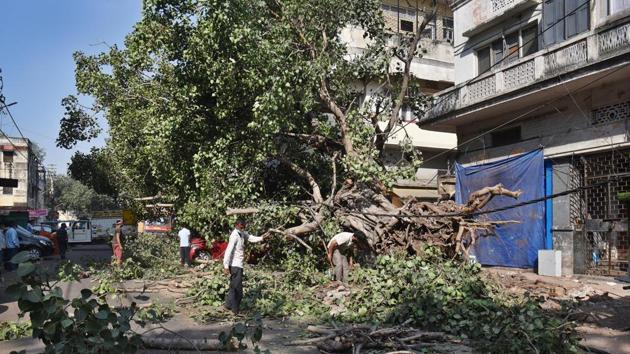Experts sound caution over Delhi’s new tree policy
The survival rate of transplanted trees is very low while the process itself incurs a high cost and so the 80% target set under the policy is not achievable, the experts cautioned.
Experts and green activists have sounded a note of concern over the Delhi government’s new tree transplantation policy, saying most native and old trees cannot survive translocation.

The survival rate of transplanted trees is very low while the process itself incurs a high cost and so the 80% target set under the policy is not achievable, the experts cautioned.
The new policy aims to preserve trees that are hundreds of years old, and which are affected by development projects. Under the policy, 80% of trees uprooted for any construction or development project must be mandatorily transplanted. In addition, it must be ensured at least 80% of the transplanted trees survive after a year, it says.
Pradip Krishen, an environmentalist and author, said the policy is not reliable as there is neither as much experience or enough expertise on transplantation. “Older trees are susceptible to dying on being translocated, as they are not able to survive the shock of being uprooted. Trees with deep tap-root system do not have a chance of survival at all. This includes all native trees such as jamun and babool, among others. Only some ficus varieties such as peepal, bargad and pilkhan can survive transplantation,” Krishen said.
Krishen said the policy should have been about how to integrate trees within development projects. “During the 1982 Asian Games, a stretch on Lodhi Road with a thick tree line was widened while keeping the trees intact. Solutions such as these could be found with political will, as trees are our heritage just like buildings and other structures.”
The Delhi government did not respond to requests for a comment.
The new transplantation policy will be in addition to the existing one that mandates plantation of 10 trees for every tree that is cut.
Warning that the policy would pave the way for the removal of thousands of trees for construction projects, experts said the government should implement provisions of the Delhi Preservation of Trees Act, 1994, and make the Tree Authority more effective. They said the cost incurred in the scheme could be used for planting native species across the city’s degraded forests.
“Transplantation is an extremely expensive and high-maintenance procedure and is not a viable option where large-scale tree felling of thousands of trees are involved. Therefore, it important to revive Delhi’s Tree Authority and strengthen policies that encourage tree protection rather than tree felling,” Kanchi Kohli, senior researcher, Centre for Policy Research, said.
Citing from his experience, Vijay Dhasmana, curator, Aravalli Biodiversity Park, Gurugram, said they had transplanted 10 jamun trees that were being felled on the roadside, inside the park at least a decade ago. “Since the trees were being felled for a road project, we tried to save them by translocating them within the park. However, since native trees are too sensitive, 10 years later, now only three of those are left and are struggling to survive. So, if the policy is aiming at 80% survival of transplanted trees, it’s neither achievable nor feasible,” he said.
Dhasmana said even though transplantation is better than just felling a tree, the survival rate and the kind of species that are known to survive post-operation is quite low.
Others pointed out that a successful transplantation would depend on the species, age, size and health of trees besides other factors such as soil condition and expertise.
C R Babu, professor emeritus at Centre for Environmental Management of Degraded Ecosystem in Delhi University, said transplantation is the last option in any effort to conserve or secure greens in urban centres. “It is not an alternative option. Only young and shallow-rooted species are known to survive after being transplanted. The extent of mortality of a transplanted tree in case of old and full-grown trees is 99%,” Babu said.
Babu said only some ficus species such as peepal, bargad and gular can survive on translocation. “However, transplanted trees take years to regrow and still don’t get a full shape or a canopy. At the same time, a young sapling can grow into a much healthier tree over time. Without a canopy, a tree cannot provide ecological services, which is the main function of it,” he added.
Stay updated with all top Cities including, Bengaluru, Delhi, Mumbai and more across India. Stay informed on the latest happenings in World News along with Delhi Election 2025 and Delhi Election Result 2025 Live, New Delhi Election Result Live, Kalkaji Election Result Live at Hindustan Times.
Stay updated with all top Cities including, Bengaluru, Delhi, Mumbai and more across India. Stay informed on the latest happenings in World News along with Delhi Election 2025 and Delhi Election Result 2025 Live, New Delhi Election Result Live, Kalkaji Election Result Live at Hindustan Times.






